10 Best Online Stock Brokers
Some products in this article are from our partners. Read our Advertiser Discloser.
Trading stocks is one of the most rewarding ways to build wealth. Maybe you’re an investor who has until now stuck to relatively safe investments like mutual funds, exchange traded funds (ETFs) or index funds.
If you think you’re ready to ready to expand your portfolio beyond funds, you may need to switch to a stock-friendly brokerage firm.
The best online stock brokerages make it easy and affordable to trade individual stocks. Most of them let you invest in mutual funds and ETFs as well. Or, you can open a second investment account just for trading individual stocks.
Several brokerages even offer free trades for new clients. These bonuses can save you money.
Top Online Stock Brokers
The best brokerage firm for your 401k might not be the best option for trading stocks.
Factors you need to look at when picking a brokerage:
- Trade fees
- Investment options
- Research tools
- Platform layout
Any brokerage site can help you make money, but each one offers a different trading experience. Frequent traders want advanced trading tools. “Buy and hold” investors might want a site with more learning tools and access to commission-free ETFs.
1. TD Ameritrade
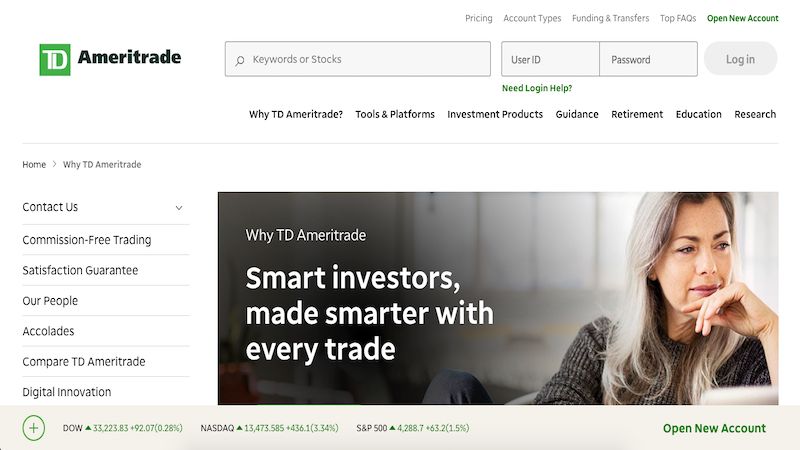
Best For: All investors
Account Options: Taxable brokerage and IRA
Account Minimum: $0
Stock Trades: $0 per trade
Reinvest Dividends?: Yes
TD Ameritrade is often named one of the best online stock brokerages. Leading investing magazines and websites rank TD Ameritrade #1 for these areas:
- Mobile app
- Website platforms
- Customer service
- Education
For the best overall experience, I recommend TD Ameritrade. TD Ameritrade has local branches across the U.S., so you can visit these locations if you prefer in-person access.
But the main reason why I like Ameritrade is its research tools. If you’ve only used free investing apps, you’re in for a treat. The Ameritrade site contains an extensive learning library and trading tools. The in-depth research reports let you research and trade stock on one site.
The web platform is also easy to use and provides a lot of information you can customize. You can quickly access information about your investment account performance, as well as upcoming market events and current market news.
All investors can benefit from the TD Ameritrade experience. If you like trading ETFs, you can buy or sell more than 300 funds commission-free.
Another reason to like TD Ameritrade is that there is no minimum balance required to open an account. Other brokerages require $500 or more to open an account. So if you’re just starting to invest, this is a good option.
Pros
Here are the main reasons to invest with TD Ameritrade.
300+ Commission-Free ETFs
While this article focuses on the best brokerages to trade stocks with, most people (including myself) still trade ETFs. ETFs let me own small positions of many companies in certain industries and the broad market. Not having to pay a commission means I can make a monthly investment for free.
Extensive Mobile App
Most online brokerages are placing greater emphasis on mobile app trading, but TD Ameritrade is the mobile app pioneer. It has one of the most extensive mobile apps for trading and research.
TD Ameritrade now also lets you make trades using your Amazon Echo home device with voice commands. So, now you don’t even need to look at your phone to make a trade.
Thinkorswim
Advanced traders who want to trade options, short stocks, or day trade will like the thinkorswim desktop platform. You will find the most research tools for technical analysis. This platform also has a simulator called paperMoney that lets you practice new trading strategies.
Automatic Dividend Reinvestment (DRIP)
If your investments pay dividends, Ameritrade will reinvest them to buy more of the same stock. Many investors call this “DRIP Investing.” DRIP stands for Dividend ReInvestment Plan.
Let’s say you receive a $5 dividend from your Apple stock. TD Ameritrade reinvests the dividend so you own $5 more of Apple stock. This new stock will earn future dividends, too. Another name for this passive income stream is compound interest.
You can also request cash payment to use your dividends to buy a different stock.
Cons
No In-House ETFs
Unlike other online stock brokerages, TD Ameritrade doesn’t have its own “in-house” ETFs. Most brokerages offer their own ETFs as the primary commission-free ETF. Not so with TD Ameritrade.
Some of Ameritrade’s commission-free ETFs come from iShares, SPDR, and First Trust. These are some of the most respected ETF fund families in the industry.
Still, the problem with using non-broker ETFs is that the brokerage firm can remove them from the commission-free list. All of a sudden, you must begin paying a trading fee. To hedge against unexpected fee hikes, go with an in-house ETF at a different brokerage site.
High Sell Fees on Commission-Free ETFs
If you sell a commission-free ETF within 30 days of purchase, you will pay a $19.99 short-term trading fee. Most short-term traders focus on stocks, not ETFs so it’s not an issue. But, keep this in mind in case you do decide to buy ETFs. Don’t buy on a whim. Perform your due diligence.
2. Ally Invest
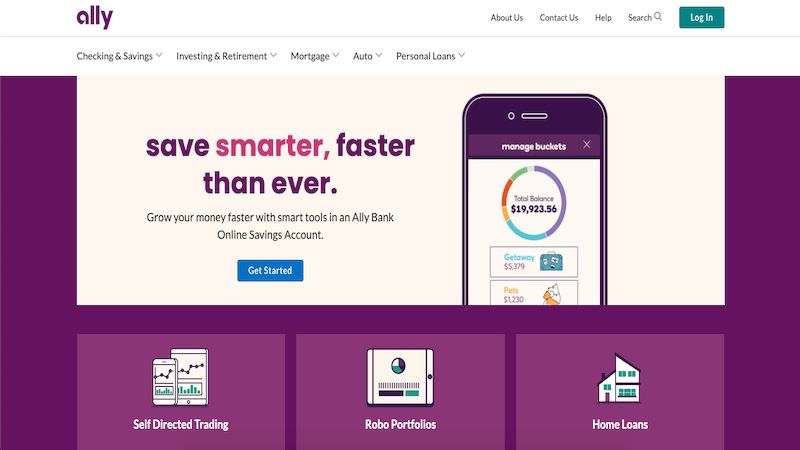
Best For: All investors
Account Options: Taxable brokerage and IRA
Account Minimum: $0
Cost to Buy or Sell Stocks: $0
Reinvest Dividends?: Yes
Ally Invest is another solid option for beginners and active traders. The normal trade fee is $0 for stocks and ETFs.
And, Ally Invest doesn’t require a minimum account balance to open an account.
You won’t find as many research tools as TD Ameritrade has, but you can buy the same investments for less. One chart you might enjoy is Ally’s Probability Calculator. It projects if you can reach your investment goals based on different market risk levels.
Another Ally chart to look at is the profit/loss graph, which helps you simulate a trade before you use real money.
The website and mobile app are easy to navigate. Besides stocks and ETFs, you can also trade:
- Options
- Mutual funds
- Bonds
Like TD Ameritrade, Ally also offers free DRIP investing for your investments.
In short, Ally Invest is a great option if you want an online brokerage with a low trade fee and good research tools.
Pros of Ally Invest
$0 Trades
Good Research Tools and Mobile App
Ally also has plenty of research tools and a mobile app you’ll want to use. You don’t get all the bells and whistles that you have with Ameritrade, but the tools and app are still good.
Cons of Ally Invest
Only 500 Commission-Free ETFs
Allly offers more than 500 commission-free ETFs from Blackrock (iShares) and WisdomTree. But other brokerage sites still offer more free ETFs.
3. Robinhood

Best For: All investors
Account Options: Taxable brokerage only
Account Minimum: $0
Cost to Buy or Sell Stocks: Free
Reinvest Dividends?: No
Robinhood is a barebones online stock brokerage site. You can buy any stock, ETF or stock option on the site for free. But, you don’t have the research and charting tools that other online brokerages offer.
Choose Robinhood for free stock trades. You will have to research your stock elsewhere.
Advanced investors can use Robinhood, too. Other than the fact that the research tools are sparse, there aren’t many limitations — but this can be said of all free investing apps.
For researching potential investments, Robinhood provides basic performance history charts and market news. This is the same information you can find for free on other investing websites. If you want more detailed research, you need a brokerage site that charges a trade fee.
Some investors open an investing account to get free trades. Then they use another brokerage site to perform their research. I do this so I can invest without the sting of paying a trade fee.
Other free apps only execute trades once a day. (Don’t miss the narrow trading window with these apps. You have to wait until the next day if you miss it.)
The nice thing about Robinhood is you can trade stocks in real time the whole time the market is open.
You can also trade stock options for free, though this is an opportunity best suited for advanced investors. No other online brokerage lets you do this on an everyday basis.
Pros of Robinhood
Free Stock and Options Trading During Market Hours
Robinhood is a good option for first-time investors. You can trade stocks with limited income without having to pay trade fees.
Expert investors choose Robinhood, too. They want a basic online brokerage with minimal costs. After all, no trade fees mean more cash to trade stocks.
Robinhood is the cheapest way to trade stocks, ETFs and options. Trades are executed during normal market trading hours, not in a one-hour block like some other brokerages.
Available on Mobile App and Website
Robinhood started as a mobile-only stock brokerage, which means it has one of the best apps for trading stock. It also now offers a web platform so you can trade from your computer.
You Can Create Limit Orders
Other free investing apps only let you trade stocks with market orders. This means you buy or sell stock shares at the current market price. For most investors this is pleasingly simple. And, it doesn’t encourage you to time the market.
But, maybe you want to buy stock at a lower price than the current market value. Your two options are watching the stock price until it drops to your buying range. Or, you place a limit order.
With a limit order, you tell the broker your highest “buy” price. Let’s say a stock currently trades for $52 but you are only willing to pay $50 per share. When you place a limit order, your trade doesn’t execute until the price drops to $50.
Most investors can’t watch the share price movement for each minute the market’s open. These special order types help you buy and sell at a better price. And, they can save you time in the process.
Here’s another example of a limit order: Sometimes I buy stocks with a “buy up to” price. Maybe the “buy up to” price is $20. That means I only buy a stock or add to my position when the stock price is $20 or less. If it’s above $20, I wait to buy.
Don’t feel forced to buy a stock right away. I usually put many stocks on my watchlist to monitor their performance before I buy.
Cons of Robinhood
Limited Research Tools
There is a tradeoff for free trades. You have very few research tools, which can make the research process tough.
Full-service brokerages offer more research tools. You may want to open an account to access these advanced tools — that’s what I do.
You Must Buy Full Shares
Unlike other free investing apps, you can only buy full shares of stock. If a stock costs $190, you must have $190 in your account.
No Retirement Accounts
Robinhood only offers non-retirement investment accounts, not IRAs like many other brokerage sites offer. With non-retirement accounts, your investment income is subject to taxes each year. But since you don’t have to pay any trade fees, you’re still saving money.
Doesn’t Reinvest Dividends
Robinhood doesn’t reinvest your dividends. Your stock dividends deposit into your cash balance. You must manually buy more stock of the same company in you want to reinvest. Or, you can invest in a new company.
4. M1 Finance
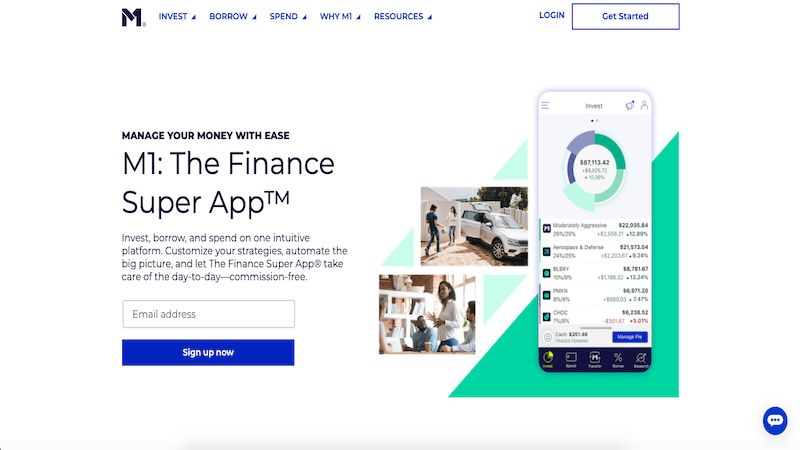
Best For: All investors
Account Options: Taxable brokerage and IRAs
Account Minimum: $100 for brokerage accounts and $500 for IRAs
Cost to Buy or Sell Stocks: Free
Reinvest Dividends?: No
Another free and functional investing app is M1 Finance. I really enjoy this app because of its many investment options.
M1 Finance lets you invest in almost any stock or ETF traded on the U.S. stock exchanges. You can even buy fractional shares of stock.
The way you build and view your portfolio with M1 is different than with other online stock brokerages. Other brokerages let you trade stocks based on dollar amounts. With M1, you assign each holding a percentage. This practice helps ensure your portfolio stays balanced.
Here’s a quick example. You build a portfolio with 20 stocks. Each stock has a 5% target allocation. So, if you invest $100, each stock position increases $5.
You must increase the target allocation to increase the position size of any one stock. Similarly, to minimize a particular position sizes, you must decrease the target allocation.
You can buy partial shares of stock on M1, too. Let’s say you want to buy Amazon stock. A single share costs around $1,900. If you only have $100 to invest at once, you can buy a 0.0526 share of Amazon. Other brokerages only let you trade full shares, so you would need the full $1,900 to buy a share.
Pros of M1 Finance
Trade Partial Shares of Stocks and ETFs
M1 is one of the few online stock brokerages that let you buy or sell partial shares. If you invest $100, M1 divides it among all your holdings.
No Trade Fees
You never pay a trade fee, which is awesome. With other brokerage firms, you must pay $4.95 for each company you invest in.
Create Custom Investment Pies
You can also build your own “mini-ETF” with M1 custom pies. I have two custom pies in my portfolio. They track model portfolios I follow online.
I can buy partial shares of 15 stocks at once. And, I don’t need a large sum of cash to do it. Custom pies give you instant market exposure to multiple stocks without paying trade fees.
Invest in Pre-Made Expert Pies
If you don’t want to pick your own stocks, you can also invest in a pre-made pie. Depending on the pie’s investing strategy, you will invest in stocks or ETFs. Some custom pies invest in both.
Cons
Only One Daily Trading Window
You can’t buy or sell positions in real-time with M1. The trading window opens at 10 a.m. Eastern time. It closes when all previous requests fill. Same-day fulfillment isn’t guaranteed after 10 a.m.
All trades are “market orders,” meaning you’ll trade at the current buy or sell price.
If you want other types of orders, go with Robinhood. You still can trade stocks for free with Robinhood.
$10 Trade Minimum
You must invest at least $10 at a time to execute a trade. This way, M1 invests at least $0.01 in each stock.
M1 Invests All Available Cash Balances Greater than $10
Don’t put cash into your M1 Finance account until you’re ready to buy stock. Once your cash balance is above $10, M1 invests the balance. Your money is in the market the next day. Any cash you want on the sidelines needs to stay in your checking account.
5. Stockpile
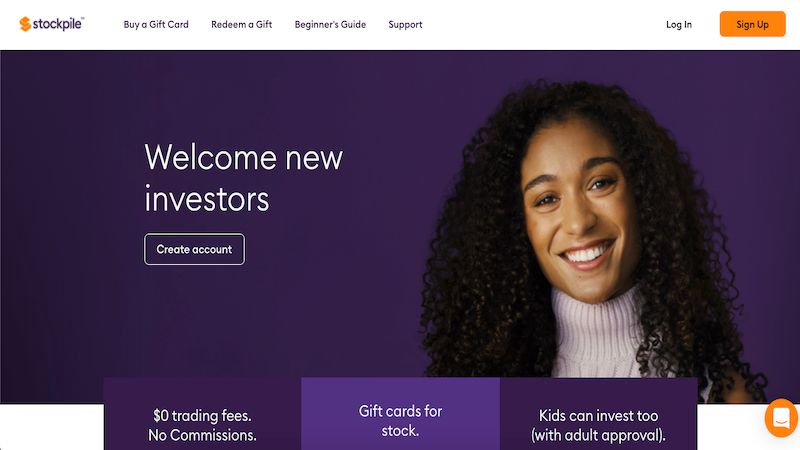
Best For: Beginner investors and children
Account Options: Taxable brokerage accounts only
Account Minimum: $0
Cost to Buy or Sell Stocks: $0.99 per trade
Reinvest Dividends?: Yes
Stockpile is a unique investing platform. It’s the best alternative to M1 Finance if you want these benefits:
- Buy or sell partial shares
- Dollar-based investing instead of percentage-based investing
- $0.99 trades
You might like Stockpile because you can buy children gifts of stock. Children can then learn how to invest with low trade fees of 99 cents.
The largest downside to Stockpile is its small investment portfolio. You can invest in more than 1,000 of the most common stocks and ETFs. But, the lack of certain other companies and ETFs might surprise you.
For instance, you can invest in common household names like Nike or Starbucks. These stocks trade on the Nasdaq and New York Stock Exchange. But, you can’t buy stocks that trade on smaller exchanges like the BATS. Foreign over-the-counter (OTC) stocks aren’t available, either.
That won’t affect most first-time investors, but experienced investors will find Stockpile lacking in options.
Also, Stockpile only has one daily trading window and its research platform is barebones.
For those reasons, active traders should avoid this site. But for the cheapest trades and a basic brokerage site, Stockpile fits the bill.
In my experience, the Stockpile mobile app is better than the website. It’s easier to track your investment performance in the app. And, you can easily fund your account or schedule trades.
Pros
99-Cent Trades
It costs 99 cents to buy or sell shares on Stockpile. Each trade must be at least $1 to execute.
Partial Share Purchases
Like M1 Finance, you can buy partial shares of stocks and ETFs. Say you want to invest $100. Stockpile invests the entire amount in the stock of your choice, even when $100 doesn’t buy a full share.
Automatic Dividend Reinvestment
Stockpile reinvests share dividends, which is unique among the bargain brokerages. In comparison, Robinhood and M1 both deposit the dividend into your cash account. Stockpile offers cash payment too. DRIP investors will appreciate the reinvestment option.
Cons
Single Daily Trading Window
You must submit your trade request before 3 p.m. Eastern time for same-day fulfillment. The number of shares you’ll receive depends on the daily closing price.
In this way, trading stocks with Stockpile is like trading mutual funds elsewhere. You can place trade requests at any time of day. However, you won’t find out the exact price until after the market closes.
Limited Investment Offerings
You probably won’t buy all 1,000+ stocks and ETFs, but in time you may find a stock or ETF you want to buy on Stockpile but can’t.
There are two options in this case:
- Invest with another brokerage firm
- Find an alternative investment
You also can’t trade mutual funds, bonds or options on Stockpile.
Barebones Platform
Stockpile is probably the simplest of the discount online brokerages. Its research tools are minimal and you can’t create joint accounts or IRAs.
6. E*TRADE
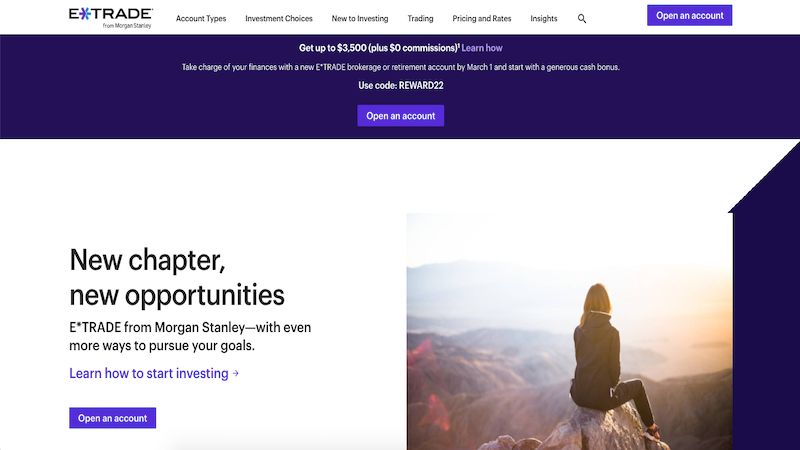
Best For: All investors
Account Options: Taxable brokerage accounts and IRAs
Account Minimum: $500 for non-retirement accounts. $0 for IRAs
Cost to Buy or Sell Stocks: $0
Reinvest Dividends?: Yes
E*TRADE is another full-service brokerage site that provides many tools for trading stocks. The mobile app and research tools are highly rated.
You also have over 250 commission-free ETFs to choose from. Some of the fund families include Vanguard, iShares and Invesco.
Most investors find everything they need with the web platform and mobile app. Both products let you perform extensive research and execute trades.
Beginner investors will find E*TRADE friendly to use, too. And, you’ll find plenty of material to learn more about investing.
Pros
Extensive Research Tools
E*TRADE was once a barebones online brokerage, but that’s not true anymore. Now you can research and trade on the same platform.
Investors of any experience level will find all the tools useful. The tools help you make smart investing decisions. E*TRADE’s mobile app is also very useful.
Discounted Trades for Active Traders
Not every online brokerage offers the advanced tools that active traders rely on. E*TRADE gives you these tools.
Lots of New Investor Learning Tools
New investors will find all the learning articles and courses they need at E*TRADE. Other full-service online brokerages don’t have this large of a library. That’s surprising, since E*TRADE has a name for being a budget online brokerage.
Cons
$500 Minimum Initial Balance for Non-Retirement Accounts
To open a taxable brokerage account, you must deposit at least $500. (The $500 requirement doesn’t apply to any IRA accounts.)
If you’re looking for commission-free ETFs and you like the E*TRADE platform, E*TRADE might be right for you.
7. Interactive Brokers
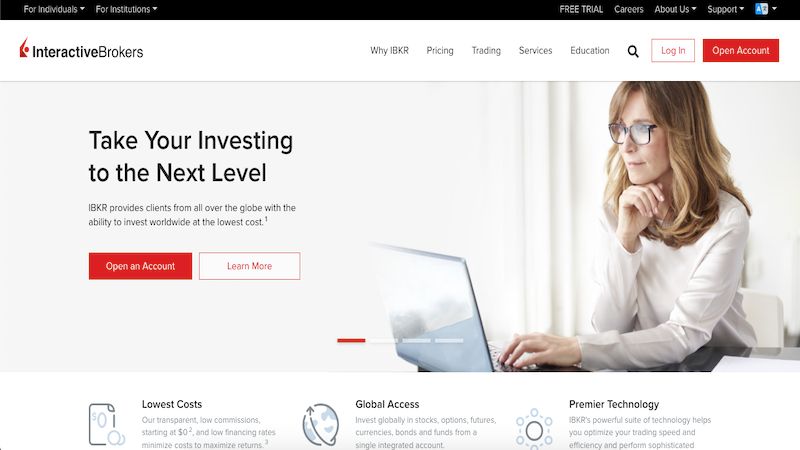
Best For: Frequent traders and global investors
Account Options: Taxable brokerage accounts and IRAs
Account Minimum: $10,000 for brokerage accounts and $5,000 for IRAs
Cost to Buy or Sell Stocks: $0.005 per share, $1 minimum per trade, up to 1% of trade value
Reinvest Dividends?: Yes
The most active traders can save money by using Interactive Brokers instead of some other brokerages. However, you must have at least $5,000 to open an IRA or $10,000 to open a taxable account.
Use Interactive Brokers when you benefit from its graduated commissions. This can be cheaper than paying $3.95 per trade with Ally Invest. Trading stocks on Interactive Brokers costs $0.005 cents per share, and when you trade more than 300,000 shares a month, the costs can be even lower. Many commission-free ETFs are also available.
If you want to invest in foreign stocks, you have direct access to 26 countries. You’ll pay less in fees than at other brokerage sites. Buying directly on foreign exchanges can be expensive if you don’t use the right service, such as Interactive Brokers.
Pros
Low Costs for the Most Active Traders
Expert traders should consider Interactive Brokers. You can pay less per trade than at other online stock brokerages.
Direct Access to Foreign Markets
It’s easy to directly invest in foreign companies with Interactive Brokers. This can be a better deal than buying the U.S.-listed equivalent.
Cons
Only for Active Traders
You should only join Interactive Brokers if you are an active trader. Investors who only make a handful of trades each month will pay monthly fees for not making enough trades. These fees are higher than those you’d pay at discount brokerages.
8. Fidelity
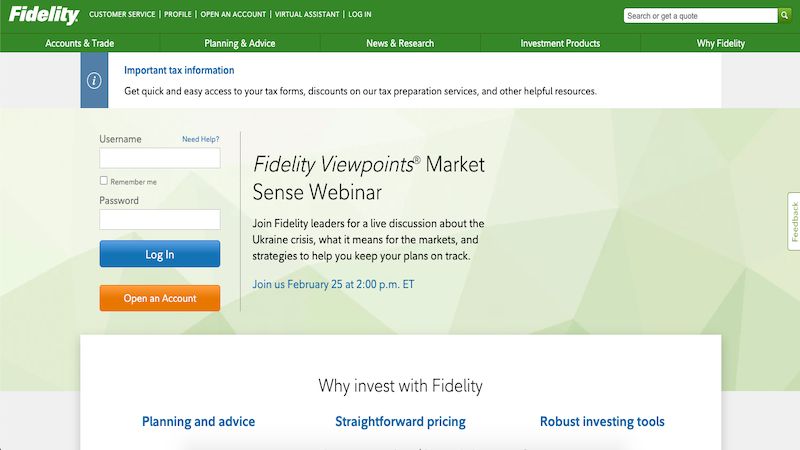
Best For: All Investors, especially mutual fund fans
Account Options: Taxable brokerage accounts and IRAs
Account Minimum: $2,500 for brokerage accounts and $0 for IRAs
Cost to Buy or Sell Stocks: $0 per trade
Reinvest Dividends?: Yes
A lot of investors like using Fidelity because their employer 401k plans are there. If you already use Fidelity and like its platform design, stay with it. Knowing the platform makes the learning curve for trading stocks easier.
Fidelity is a low-price leader with a loyal following. It has 265 commission-free ETFs, and all stock and ETF trades cost $0.
If you like mutual funds, Fidelity is a good option, too. It waives the minimum initial investment for most funds. And, Fidelity offers two index funds with an expense ratio of 0. You keep 100% of the profits with these funds.
If you love analyst research reports, keep reading. Fidelity offers reports from 20 different providers. That’s the most of any brokerage. Its charting tools are robust, too.
Make a lot of trades? The Active Trader Pro platform is a good fit for many frequent traders.
Pros
Extensive Research Reports and Tools
Some investors read every analyst’s opinion before trading. If that’s you, Fidelity is your best option.
The Fidelity Equity Summary Score is a handy tool, too. It’s a stock health barometer. You can use it to see whether current stock sentiment is a buy, sell or hold.
These gauges never replace the need to perform your due diligence. But, research tools are the quickest way to get expert opinions. Reports and scoring tools make the research process easier.
Highly-Rated Investments Offerings
Fidelity’s mutual funds and ETFs are well regarded. These funds make it easy to diversify. You can invest in special sectors or the broad market.
Cons
Active Trader Pro Access for Frequent Traders Only
You must be an active trader to access Fidelity’s Active Trader Pro. That means you must make at least 36 trades in a 12-month period to get access to the advanced tools.
Most casual investors won’t care, but maybe you do. Maybe you have advanced skills but not enough money to be an active trader yet. Know that other brokerages offer their advanced platforms to everyone. For example, you can use TD Ameritrade thinkorswim for free.
9. Charles Schwab
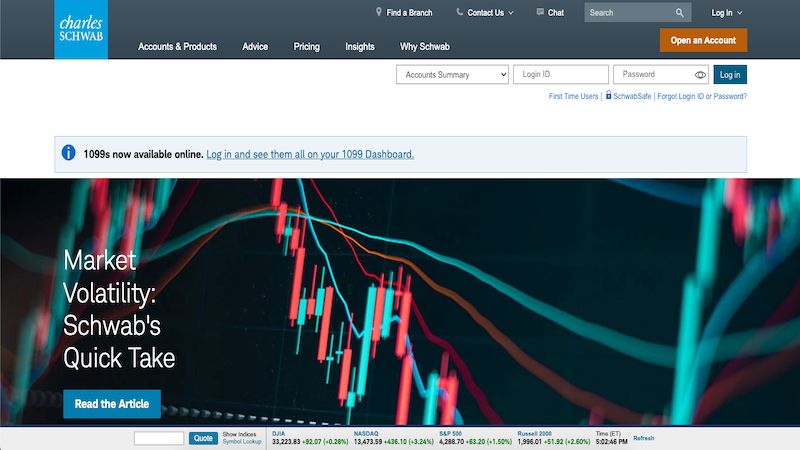
Best For: All investors
Account Options: Taxable brokerage accounts and IRAs
Account Minimum: $1,000 for all accounts
Cost to Buy or Sell Stocks: $0 per trade
Reinvest Dividends?: Yes
Charles Schwab is another well-liked online stock brokerage. It finishes strong in most investing categories.
Schwab’s trading fee for stocks and ETFs is $0. It offers 200+ commission-free ETFs and its index mutual funds have low fund expenses.
Beginners and advanced traders can both enjoy trading on Schwab.
The web platform for average investors is more than sufficient. It has extensive charting tools and third-party research reports.
The StreetSmart Edge platform is for advanced traders, though it’s free to all investors. For more bells-and-whistles, stick with TD Ameritrade, though.
Pros
$0 Trades for Stocks and ETFs
Charles Schwab has competitive fees for trading stocks and ETFs. It has more than 200 ETFs from 16 fund families that are commission-free. Schwab manages most of these ETFs “in-house.”
Extensive Research and Rating Resources
Fidelity has more research reports, but Schwab isn’t far behind. You won’t have trouble finding analysts’ reports and stock ratings for most stocks.
Cons
Mediocre Mobile App
One drawback to Schwab is a relatively basic mobile app. While it’s not a bad app, it’s not the best app. Beyond basic charting and trading, it trails the pack in ease of use. This would have been fine for a leading online stock brokerage 10 years ago, but not today.
That said, the Schwab mobile app is still better than most of the free apps. If you plan on trading from your mobile device, tread lightly. Think about avoiding Schwab until the app improves.
10. Vanguard
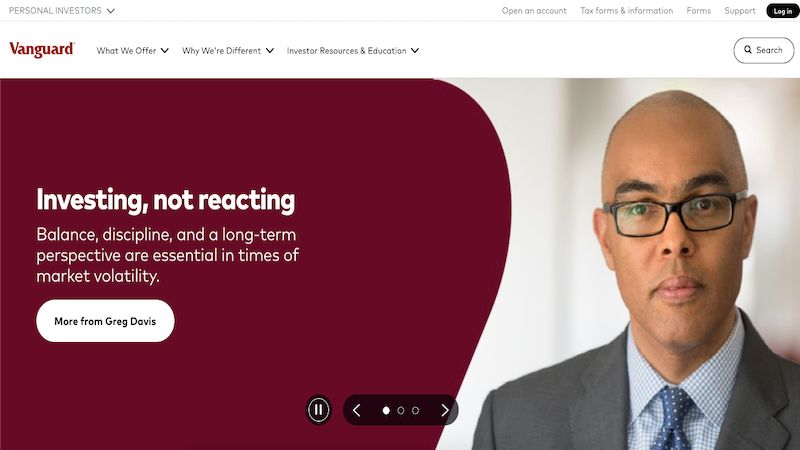
Best For: All investors
Account Options: Taxable brokerage accounts and IRAs, 529’s and more
Account Minimum: $1,000 – $3000 depending on the investment
Cost to Buy or Sell Stocks: $0 per trade
Reinvest Dividends?: Yes
This is one of the most renown stock brokerage firms around. Vanguard was started in 1975 by John Bogle and is best known for their low-cost the index funds.
Summary
All of these online stock brokerages make trading stock quick and easy. Brokerages that charge trade fees offer more tools. Free investing apps are efficient too when you want to keep things simple.
All opinions expressed in this article are the authors. We are compensated by businesses that are mentioned in this article through affiliate links.

